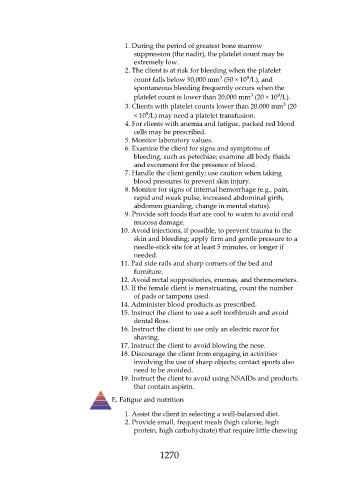Page 1270 - Saunders Comprehensive Review For NCLEX-RN
P. 1270
1. During the period of greatest bone marrow
suppression (the nadir), the platelet count may be
extremely low.
2. The client is at risk for bleeding when the platelet
9
3
count falls below 50,000 mm (50 × 10 /L), and
spontaneous bleeding frequently occurs when the
3
9
platelet count is lower than 20,000 mm (20 × 10 /L).
3
3. Clients with platelet counts lower than 20,000 mm (20
9
× 10 /L) may need a platelet transfusion.
4. For clients with anemia and fatigue, packed red blood
cells may be prescribed.
5. Monitor laboratory values.
6. Examine the client for signs and symptoms of
bleeding, such as petechiae; examine all body fluids
and excrement for the presence of blood.
7. Handle the client gently; use caution when taking
blood pressures to prevent skin injury.
8. Monitor for signs of internal hemorrhage (e.g., pain,
rapid and weak pulse, increased abdominal girth,
abdomen guarding, change in mental status).
9. Provide soft foods that are cool to warm to avoid oral
mucosa damage.
10. Avoid injections, if possible, to prevent trauma to the
skin and bleeding; apply firm and gentle pressure to a
needle-stick site for at least 5 minutes, or longer if
needed.
11. Pad side rails and sharp corners of the bed and
furniture.
12. Avoid rectal suppositories, enemas, and thermometers.
13. If the female client is menstruating, count the number
of pads or tampons used.
14. Administer blood products as prescribed.
15. Instruct the client to use a soft toothbrush and avoid
dental floss.
16. Instruct the client to use only an electric razor for
shaving.
17. Instruct the client to avoid blowing the nose.
18. Discourage the client from engaging in activities
involving the use of sharp objects; contact sports also
need to be avoided.
19. Instruct the client to avoid using NSAIDs and products
that contain aspirin.
E. Fatigue and nutrition
1. Assist the client in selecting a well-balanced diet.
2. Provide small, frequent meals (high calorie, high
protein, high carbohydrate) that require little chewing
1270

